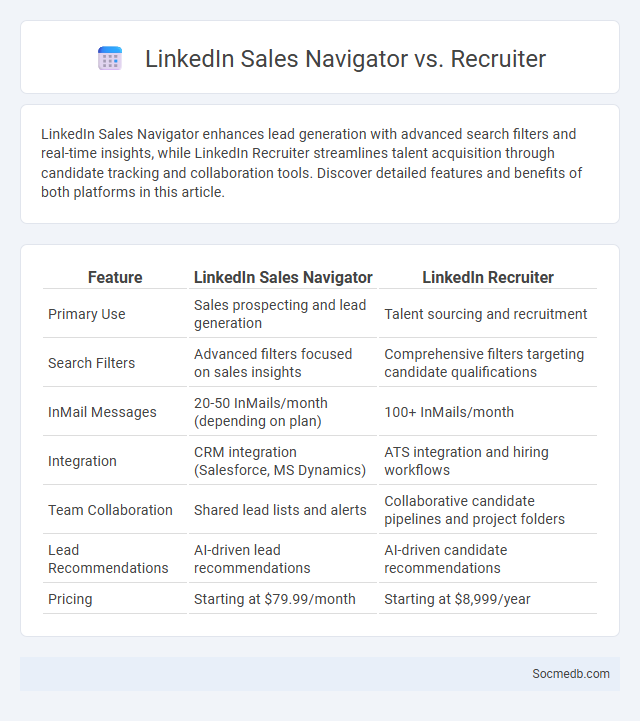
Photo illustration: LinkedIn Sales Navigator vs Recruiter
LinkedIn Sales Navigator enhances lead generation with advanced search filters and real-time insights, while LinkedIn Recruiter streamlines talent acquisition through candidate tracking and collaboration tools. Discover detailed features and benefits of both platforms in this article.
Table of Comparison
| Feature | LinkedIn Sales Navigator | LinkedIn Recruiter |
|---|---|---|
| Primary Use | Sales prospecting and lead generation | Talent sourcing and recruitment |
| Search Filters | Advanced filters focused on sales insights | Comprehensive filters targeting candidate qualifications |
| InMail Messages | 20-50 InMails/month (depending on plan) | 100+ InMails/month |
| Integration | CRM integration (Salesforce, MS Dynamics) | ATS integration and hiring workflows |
| Team Collaboration | Shared lead lists and alerts | Collaborative candidate pipelines and project folders |
| Lead Recommendations | AI-driven lead recommendations | AI-driven candidate recommendations |
| Pricing | Starting at $79.99/month | Starting at $8,999/year |
Introduction to LinkedIn Sales Navigator, Recruiter, and Social Selling
LinkedIn Sales Navigator offers advanced lead-building tools and personalized algorithms to help you identify and engage with potential customers effectively. Recruiter streamlines the hiring process by providing robust candidate search filters, enabling targeted recruitment and talent pipeline management. Social Selling leverages LinkedIn's network to build relationships, establish trust, and generate sales opportunities through strategic content sharing and interaction.
Key Features of LinkedIn Sales Navigator
LinkedIn Sales Navigator offers advanced lead and company search filters designed to help you identify potential prospects with precision. Its real-time sales updates and personalized algorithm improve engagement by providing insights into decision-makers' activities and interests. The platform also integrates seamlessly with your CRM, enhancing workflow efficiency and ensuring your sales outreach is data-driven and targeted.
Core Capabilities of LinkedIn Recruiter
LinkedIn Recruiter offers powerful search filters and advanced algorithms to help you identify and engage top talent efficiently. Its integrated communication tools streamline candidate outreach and relationship management, enhancing recruitment workflows. Robust analytics provide insights into hiring trends and campaign performance, optimizing your recruitment strategy.
Understanding Social Selling on LinkedIn
Social selling on LinkedIn leverages the platform's professional network to build relationships and drive sales by sharing valuable content, engaging with prospects, and utilizing LinkedIn Sales Navigator tools. By identifying decision-makers and nurturing connections through personalized communication, businesses can increase trust and shorten sales cycles. Effective social selling strategies on LinkedIn result in higher lead conversion rates and improved brand authority within targeted industries.
Target Audience Comparison: Sales Navigator vs Recruiter
Sales Navigator offers advanced lead filters and CRM integration tailored for sales professionals targeting decision-makers and potential clients, while Recruiter provides sophisticated candidate search filters and pipeline management designed for HR specialists focusing on talent acquisition. Your choice depends on whether you prioritize sales prospecting or recruitment needs, with Sales Navigator enhancing client outreach and Recruiter optimizing candidate sourcing. Understanding these platform distinctions ensures more efficient and targeted social media engagement for your business goals.
Pricing and Subscription Differences
Social media platforms vary significantly in pricing and subscription models, with services like LinkedIn Premium offering tiered plans ranging from $29.99 to $99.95 monthly, providing enhanced networking and job search tools. Facebook remains largely free, monetizing through ads rather than subscriptions, while Twitter Blue charges $8 monthly for features like undo tweets and customization. Instagram currently lacks a subscription model but experiments with exclusive content access via paid subscriptions for creators.
Lead Generation Effectiveness Across Platforms
Social media platforms vary significantly in lead generation effectiveness, with LinkedIn delivering higher-quality B2B leads due to its professional user base, while Facebook offers broader reach and advanced targeting for diverse demographics. Instagram excels at visually engaging younger audiences, driving strong conversion rates through Stories and shoppable posts. To maximize your ROI, tailor content and ads to each platform's strengths, leveraging data analytics to refine targeting and improve lead quality continuously.
User Experience and Interface Comparison
Social media platforms vary significantly in user experience and interface design, with Instagram offering a visually-driven, minimalist layout that prioritizes image and video content, while Twitter focuses on real-time text updates and a streamlined feed for quick information consumption. Facebook provides a comprehensive interface combining multimedia sharing, community groups, and marketplace features, aiming for versatility but often perceived as cluttered. User satisfaction often hinges on intuitive navigation, loading speeds, and personalized content algorithms, which directly impact engagement and retention rates across platforms.
Pros and Cons of Each LinkedIn Tool
LinkedIn offers several tools such as LinkedIn Learning, LinkedIn Sales Navigator, and LinkedIn Recruiter, each with distinct advantages and challenges. LinkedIn Learning provides extensive educational content ideal for skill enhancement, but it requires a subscription that may not fit every budget. LinkedIn Sales Navigator excels at targeted lead generation yet can be complex for beginners, while LinkedIn Recruiter streamlines talent acquisition but may lead to information overload if not managed correctly, impacting Your overall networking efficiency.
Choosing the Right Solution for Your Business Goals
Identifying the most effective social media platform depends on your business goals, target audience, and content type to maximize engagement and ROI. Analyze key metrics like demographics, user behavior, and platform features to ensure alignment with your brand's objectives. Your strategic choice of social media channels directly influences visibility, customer interaction, and overall marketing success.
 socmedb.com
socmedb.com